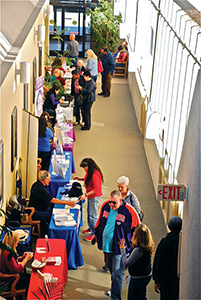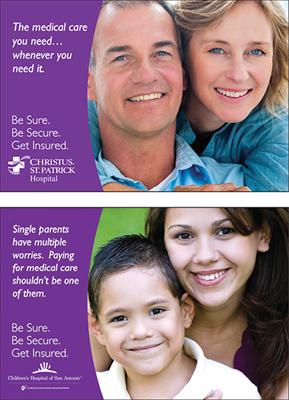Bilingual materials and on-site child care smooth the process
By JULIE MINDA
At one of several insurance enrollment fairs that CHRISTUS Health Shreveport-Bossier held in Shreveport, La., during open enrollment, Sr. Sharon Rambin, SFCC, spotted a woman thrusting her fist in the air in celebration as she exited the event.
Curious, Sr. Rambin approached the woman, who appeared to be in her late 50s, and asked why she was so happy. She said: "For the first time in my life, I have health insurance."
As manager of community health for CHRISTUS Health Shreveport-Bossier, Sr. Rambin has helped organize several large-scale insurance enrollment drives in the Shreveport area. The drives were among nearly 300 enrollment events held throughout CHRISTUS Health's four-state area during 2015 open enrollment, which began Nov. 15 and ended Feb. 15.
Over the past two years, the Irving, Texas-based system, which has nearly 40 hospitals and a network of other facilities in the U.S., has given $500,000 and broad system support to its regions to help them plan and carry out outreach, events and other efforts to educate uninsured community members about why and how to get insured. The goal is to enroll eligible people in commercial insurance on the health insurance exchanges established by the Affordable Care Act, or into Medicaid. (Medicaid was expanded in two of the states where CHRISTUS Health operates — Arkansas and New Mexico — but not in the other two — Louisiana and Texas.)
System support
Abby Lowe McNeil, CHRISTUS Health system director of communications and public affairs, is helping to lead a task force that coordinates the work. She said enrollment efforts are a priority for CHRISTUS Health because it champions health coverage for all. "This commitment is based on Catholic social justice teaching and a mission of service to the poor," she said.

Attendees visit stations for registration, prescreening and information at a February enrollment event at a medical-dental building at CHRISTUS St. Vincent Regional Medical Center in Santa Fe, N.M.
A designated leader from each of the system's eight regions and system-level experts participate in the task force.
CHRISTUS Health provided outside consultants to the regions to help them aggregate and analyze historical patient account information. The regions used the data to identify zip codes where community members were most likely to be uninsured and to qualify for federal subsidies or Medicaid. CHRISTUS Health uses its regions' patient and other data to send out broadcast emails and personalized direct mail postcards to patients and others in hot spots about the importance of being insured and resources available to them.
CHRISTUS Health used patient data to target the message and pitch. The back-panel copy varied with the recipient's demographic profile — the language was different, for instance, for single parents, "young invincibles," families and older adults. The photos on the postcards' front panel varied based on the recipient's ethnicity. Postcards to Spanish-speaking households included a call to action in Spanish.
Sr. Rambin said the Shreveport coalition also sent paid health navigators into libraries, stores and other locations in hot spots.

Organizers of a February health insurance enrollment event at the CHRISTUS St. Vincent Regional Medical Center campus in Santa Fe, N.M., provided sitters, including Jade Vigil, at right, to entertain children while their parents signed up for coverage.
The navigators "found people had a lot of questions and misperceptions," she said. "We think it helped our enrollment efforts to have those navigators out in the community, because clearly there was a need to explain enrollment in terms the population could understand and believe."
The system also helped with targeted media outreach, which included ad buys, radio-thons and phone-a-thons in the regions before enrollment events in the target areas.
McNeil said while the system "could provide tools, best practices, guidance and even standard materials for the regional executives ... enrollment is an on-the-ground job.
"It took passion on the front lines to make the difference," she said.
Supersize that
Andrea Guajardo directs community health for CHRISTUS Santa Rosa Health System in San Antonio, and she was one of the leaders of the enrollment effort in her region. Her region's enrollment work has been among the most successful in the CHRISTUS Health network. She said, "I grew up as an uninsured person, and all of my work at CHRISTUS has been about helping the uninsured. There was no way I wasn't going to be involved once the ACA passed."

These are two of the postcards CHRISTUS Health sent out to encourage enrollment in marketplace plans in 2015. Language and images on the postcards varied according to the recipient's demographic profile, such as his or her age and ethnic background.
She helped establish and lead a coalition called Enroll San Antonio that has been active since October 2013 and that includes all five of CHRISTUS' hospitals as well as other San Antonio health care providers; Bexar County, Texas; the city of San Antonio; and several grassroots and community-based organizations.
She said during open enrollment for 2014, the coalition "got very good at hosting super extra-large enrollment events — thousands came out — and we got good at processing, screening, educating and enrolling people in one day." At the events, staff and volunteers from the coalition partners screened arrivals and educated them about the process; and application counselors from the hospitals or from federally qualified health centers helped eligible people sign up for insurance on the exchange.
Guajardo said through the experience, the coalition members discovered how important it is to tailor promotional and day-of materials and events. For instance, a large percentage of uninsured people are Hispanic; and there is a significant Hispanic population in San Antonio; and so the coalition targeted public relations efforts to Hispanic media. The coalition had bilingual staff and volunteers front and center at its events, and materials printed in English and Spanish.
Enroll San Antonio is credited with helping sign up about 76,000 people during 2014 open enrollment. For all counties served by CHRISTUS Health, 117,549 people signed up during 2014 open enrollment. For 2015 enrollment, CHRISTUS Health estimates it may have helped reach 190,076 enrollees, or re-enrollees in the counties it serves.
Ripple effect
Kathy Armijo Etre, vice president of community health for CHRISTUS St. Vincent Regional Medical Center of Santa Fe, N.M., said CHRISTUS Health support, along with contributions from partners it joined in a Santa Fe coalition, enabled the coalition to market its enrollment drives, to serve food at its drives and to have child care and entertainment available to attendees (the Santa Fe coalition included the hospital, a family medicine center, a college and Santa Fe County, among others).
Etre's colleague, April Mendoza, CHRISTUS St. Vincent patient access services director, said that organizers increased efficiency by having a registration table, and a prescreening table where screeners determined what type of insurance attendees qualified for. There was another station where attendees got help setting up email addresses, a requirement of an exchange-based insurance purchase. Next, attendees sat down with representatives who walked them through online enrollment.
Etre said the enrollment rate was low at some of the enrollment drives. But, she said, "We learned that what you're doing is bigger than one event. People may not necessarily sign up that day," but may gain enough information to sign up for insurance another day, or to encourage others to get coverage. She said this ripple effect is reflected in the fact that local enrollment numbers increased after the coalition began its outreach and events.
| CHRISTUS Health leader offers tips for enrollment push
Open enrollment for the health insurance marketplace begins Nov. 1 for coverage in 2016. Abby Lowe McNeil, CHRISTUS Health system director of communications and public affairs, and one of the leaders of a CHRISTUS Health task force that coordinates that system's efforts to support insurance enrollment, suggests Catholic health ministry providers planning to lead enrollment pushes later this year: - Start now. It's never too early to prepare for an enrollment push.
- Leverage existing connections. Most ministry providers already have worked with a community coalition, for instance, on community needs assessments or other projects. Tap those partners for enrollment drives. Hospitals and social service agencies may have trained enrollment counselors, marketing/communication departments and other staff key to enrollment event success.
- Do your homework. There are many great sources of information — like Enroll America and CHA — that have produced tools and resources.
- Use your own data. Many health care organizations have reliable data regarding where their uninsured patients are concentrated and can focus resources there for maximum impact.
|
| Health exchange and Medicaid sign-ups for 2015
According to information from the U.S. Department of Health and Human Services' website, the number of people who signed up for, or were automatically reenrolled in, health insurance for 2015 through an exchange (as of
Feb. 22) was:
- Nationwide: About 11.4 million
- In Arkansas: 65,684
- In Louisiana: 186,277
- In New Mexico: 52,358
- In Texas: 1,205,174
The number of people who have gained Medicaid or Children's Health Insurance Program coverage since the beginning of the first open enrollment period of the health insurance exchange program (as of January 2015): - Nationwide: About 11.2 million
- In Arkansas (which expanded Medicaid): 267,678
- In Louisiana (which did not expand Medicaid): 33,303
- In New Mexico (which expanded Medicaid): 230,151
- In Texas (which did not expand Medicaid): 209,534
|
| CHRISTUS Health experts note potential early results from enrollment Leaders with Irving, Texas-based CHRISTUS Health say that their regions' enrollment efforts helped to boost the number of insured people in the communities they serve, and that increase already may be benefiting facility balance sheets. The Affordable Care Act required, beginning last year, that the vast majority of Americans have insurance, or pay a penalty. Ryan Thompson, CHRISTUS Health vice president of revenue cycle services, said that based on year-to-year performance data, CHRISTUS Health facilities have seen decreases in the cost of providing charity care and in other discounts to charges to the uninsured — and "enrollment clearly played a factor." However, Thompson cautioned, "given the complexity of dealing with data regarding this entire population, it is very difficult to isolate the specific factors for this change." Thompson said when CHRISTUS Health compares its facilities in states that expanded Medicaid (Arkansas and New Mexico), with facilities in states that did not (Louisiana and Texas), "As we would expect, the regions in states that expanded Medicaid have seen a greater positive financial impact, which has helped them defray the costs of cuts they took as part of the Affordable Care Act," he said. In regions where Medicaid expansion occurred, CHRISTUS Health facilities are reporting a decrease in charity care. However, they are not seeing a change in their level of "insured" bad debt, as Medicaid patients have minimal out-of-pocket liabilities. "The CHRISTUS Health Ark-La-Tex region, which serves Texas and Arkansas, one of which expanded Medicaid and the other of which did not, saw a drop in charity care, but bad debt is flat, as we had drops in uninsured volume but increasing patient responsibility for balance after insurance. Therefore, it could be considered a 'wash out,'" Thompson said. Thompson said that anecdotally "we've heard concerns that patients in many kinds of (commercial) insurance products are moving to higher deductible plans, or choosing high deductible plans on the marketplace, and that this may be causing an increase in bad debt. While we can't determine that solely from our bad debt data, it would make sense in response to an increase in plans that require patients to pay a higher share of the cost." In states that did not expand Medicaid, Thompson said, "we continue to evaluate whether we are seeing an impact in newly covered individuals to our hospitals — or have covered individuals converted from the private market to the public exchange in order to access available premium and co-share subsidies?" |
Copyright © 2015 by the Catholic Health Association
of the United States
For reprint permission, contact Betty Crosby or call (314) 253-3477.